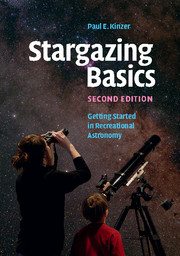4 - The Solar System
from Part II - What's up there?
Published online by Cambridge University Press: 05 August 2015
Summary
Our own star is called Sol. It, and all that orbit it, are part of the Solar System. This includes, at this time, eight planets, a large and growing number of known moons that orbit these planets, and millions of smaller asteroids and comets, which range in size from several hundred kilometers in diameter to microscopic.
Most of these objects are not visible to even the largest telescopes, since the tiny greatly outnumber the large. But many of them are excellent targets for even the smallest scope. The Sun and the Moon are the only two bodies in the heavens that clearly appear as disks to the unaided eye, rather than as points of light. Seven planets show disks when viewed through telescopes. Some of their moons are also visible.
However, what makes these objects into targets worth visiting often is that they change. The phases of the Moon, Mercury, and Venus; the appearance and passage of spots across the surface of the Sun; the polar caps of Mars; the dance of the moons of Jupiter and Saturn; all of these and more are there to see, even through beginner scopes.
In addition to these regular denizens of the solar neighborhood, there are periodic visitations from lesser-known objects. These include asteroids, comets, and meteors.
This chapter will give a brief description of all of these objects. The sections on the Moon, the Sun, and the planets will start with some statistical information; one term needs definition: Angular size is the apparent diameter of an object, when viewed in the Earth's sky. It is given in degrees (one 360th of a circle, written 1°), minutes (one 60th of a degree, written 1′), or seconds (one 60th of a minute, written 1″). The Sun and the Moon, for example, each have an angular size of about 30 minutes (30′) or half a degree. This is an amazing coincidence, and is the reason that total solar eclipses are so spectacular. But the angular sizes of these two bodies have nothing to do with their actual sizes: The actual diameter of the Moon is 3476 kilometers (2140 miles); the diameter of the Sun is about 1,390,000 kilometers (862,000 miles).
- Type
- Chapter
- Information
- Stargazing BasicsGetting Started in Recreational Astronomy, pp. 79 - 104Publisher: Cambridge University PressPrint publication year: 2015



